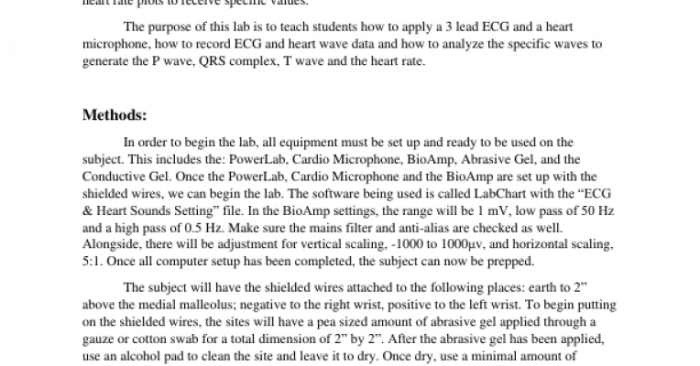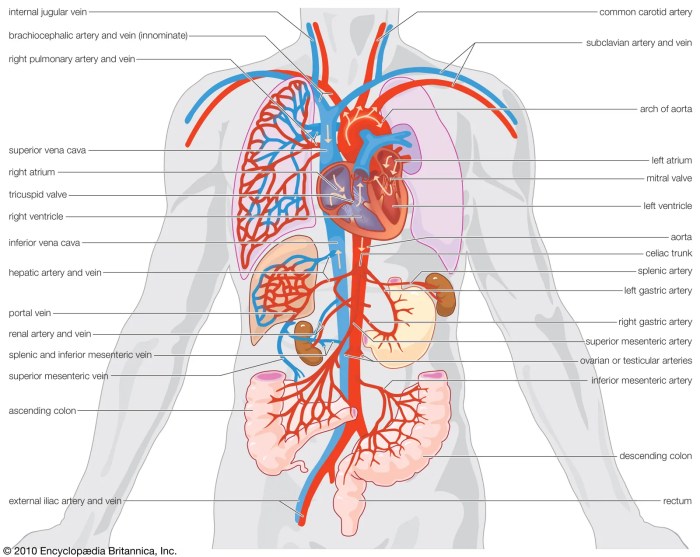Welcome to the Blood and Circulation Lab Report, a comprehensive exploration of the vital components and intricate processes that sustain life. This report delves into the composition of blood, the mechanics of circulation, and the clinical significance of blood tests and disorders, providing a thorough understanding of this fundamental aspect of human physiology.
Blood Composition and Properties

Blood is a specialized bodily fluid that performs various essential functions within the circulatory system. It is composed of a liquid matrix known as plasma, along with suspended cellular components including red blood cells, white blood cells, and platelets.
Plasma
Plasma constitutes approximately 55% of blood volume and serves as the primary fluid component. It is composed of water, electrolytes, proteins, hormones, and various other solutes. Plasma proteins, such as albumin and globulins, play crucial roles in maintaining fluid balance, transporting substances, and providing immunological defense.
Red Blood Cells
Red blood cells, also known as erythrocytes, are the most abundant cellular component in blood. They are specialized for oxygen transport and contain the protein hemoglobin, which binds to oxygen molecules and facilitates their delivery to tissues. Red blood cells are highly flexible and lack a nucleus, allowing them to navigate narrow blood vessels efficiently.
White Blood Cells, Blood and circulation lab report
White blood cells, also known as leukocytes, are responsible for defending the body against infection and disease. They are classified into various types, including neutrophils, lymphocytes, monocytes, eosinophils, and basophils, each with specific functions in the immune response.
Platelets
Platelets, also known as thrombocytes, are small, disk-shaped cells involved in blood clotting. They aggregate at sites of blood vessel damage, forming a plug that helps stop bleeding. Platelets release factors that activate the clotting cascade, leading to the formation of a stable clot.
Blood Circulation

Blood circulation is the continuous movement of blood through the body, delivering oxygen, nutrients, and hormones to the cells and removing waste products. It consists of two main pathways: the systemic circulation and the pulmonary circulation.
Systemic Circulation
The systemic circulation carries oxygenated blood from the heart to the body’s tissues and organs. It begins with the left ventricle pumping oxygenated blood into the aorta, the largest artery in the body. The aorta branches into smaller arteries, which further divide into arterioles, and eventually into capillaries, where gas exchange occurs.
Deoxygenated blood then flows from the capillaries into venules, which merge to form veins, and eventually return to the heart via the superior and inferior vena cava.
Pulmonary Circulation
The pulmonary circulation carries deoxygenated blood from the heart to the lungs and back. It begins with the right ventricle pumping deoxygenated blood into the pulmonary artery, which divides into two branches leading to the lungs. In the lungs, the blood exchanges carbon dioxide for oxygen, becoming oxygenated.
The oxygenated blood then flows from the lungs through the pulmonary veins back to the heart’s left atrium.
Role of the Heart, Blood Vessels, and Valves
The heart is a muscular organ that pumps blood through the body. The left side of the heart (left atrium and left ventricle) is responsible for systemic circulation, while the right side (right atrium and right ventricle) handles pulmonary circulation.
Blood vessels include arteries, arterioles, capillaries, venules, and veins. Arteries carry blood away from the heart, while veins carry blood back to the heart. Capillaries are the smallest blood vessels and allow for the exchange of substances between the blood and tissues.
Valves in the heart and blood vessels ensure that blood flows in the correct direction. They prevent backflow and maintain proper blood pressure.
Blood Pressure

Blood pressure is the force exerted by the blood against the walls of the blood vessels. It is an important indicator of cardiovascular health, as it can provide information about the heart’s pumping strength and the condition of the blood vessels.
Blood pressure is measured using a sphygmomanometer, which consists of an inflatable cuff and a pressure gauge. The cuff is placed around the upper arm, and the pressure is gradually increased until the blood flow in the brachial artery (the main artery in the arm) is blocked.
The pressure at which the blood flow is restored is the systolic blood pressure, which represents the peak pressure in the arteries during each heartbeat.
The pressure at which the blood flow is completely blocked is the diastolic blood pressure, which represents the minimum pressure in the arteries during each heartbeat. Blood pressure is typically expressed in millimeters of mercury (mm Hg), with the systolic pressure followed by the diastolic pressure, such as 120/80 mm Hg.
Factors Influencing Blood Pressure
Several factors can influence blood pressure, including:
- Heart rate:An increase in heart rate leads to an increase in blood pressure.
- Blood vessel resistance:Increased resistance in the blood vessels, such as due to atherosclerosis, leads to an increase in blood pressure.
- Blood volume:An increase in blood volume, such as due to fluid retention, leads to an increase in blood pressure.
Blood Tests

Blood tests are essential diagnostic tools used to evaluate blood composition and function. These tests provide valuable information about various health conditions, including anemia, infection, and blood clotting disorders.
Blood samples are typically collected from a vein in the arm. The collected sample is then analyzed using various techniques, including microscopy, chemical analysis, and immunological assays.
Complete Blood Count (CBC)
A complete blood count (CBC) is a common blood test that provides information about the number and types of blood cells. This test can detect abnormalities in red blood cells, white blood cells, and platelets, which may indicate various health conditions, such as anemia, infection, or leukemia.
Blood Chemistry Panel
A blood chemistry panel measures the levels of various chemicals in the blood, including electrolytes, glucose, and enzymes. This test can provide insights into organ function, electrolyte balance, and metabolic disorders.
Coagulation Profile
A coagulation profile assesses the ability of blood to clot. This test measures the levels of clotting factors and inhibitors, which are essential for proper blood clotting. Abnormalities in the coagulation profile may indicate bleeding disorders or an increased risk of thrombosis.
Immunological Assays
Immunological assays detect the presence of antibodies or antigens in the blood. These tests are used to diagnose and monitor immune-mediated diseases, such as autoimmune disorders and infectious diseases.
Blood Disorders

Blood disorders are conditions that affect the production, composition, or function of blood. They can range from mild to severe and can affect people of all ages.
Some of the most common blood disorders include:
- Anemia:A condition in which the blood does not have enough healthy red blood cells. This can lead to fatigue, weakness, and shortness of breath.
- Leukemia:A type of cancer that starts in the blood-forming tissue of the bone marrow. It can cause fatigue, weight loss, fever, and bleeding.
- Hemophilia:A genetic disorder that prevents the blood from clotting properly. This can lead to excessive bleeding after even minor injuries.
Anemia
Anemia is a condition in which the blood does not have enough healthy red blood cells. Red blood cells carry oxygen from the lungs to the rest of the body. When there are not enough red blood cells, the body cannot get the oxygen it needs to function properly.
There are many different types of anemia, but the most common type is iron-deficiency anemia. Iron-deficiency anemia is caused by a lack of iron in the body. Iron is essential for the production of hemoglobin, the protein in red blood cells that carries oxygen.
Symptoms of anemia can include:
- Fatigue
- Weakness
- Shortness of breath
- Pale skin
- Cold hands and feet
- Headaches
- Dizziness
Anemia can be diagnosed with a blood test. Treatment for anemia depends on the cause. Iron-deficiency anemia can be treated with iron supplements. Other types of anemia may require more specialized treatment.
Leukemia
Leukemia is a type of cancer that starts in the blood-forming tissue of the bone marrow. It can cause fatigue, weight loss, fever, and bleeding.
There are many different types of leukemia, but the most common types are acute lymphoblastic leukemia (ALL) and acute myeloid leukemia (AML). ALL is the most common type of leukemia in children, while AML is the most common type of leukemia in adults.
Symptoms of leukemia can include:
- Fatigue
- Weakness
- Weight loss
- Fever
- Bleeding
- Swollen lymph nodes
- Bone pain
- Headaches
- Nausea and vomiting
Leukemia can be diagnosed with a blood test and a bone marrow biopsy. Treatment for leukemia depends on the type of leukemia and the stage of the disease.
Hemophilia
Hemophilia is a genetic disorder that prevents the blood from clotting properly. This can lead to excessive bleeding after even minor injuries.
There are two main types of hemophilia: hemophilia A and hemophilia B. Hemophilia A is the most common type of hemophilia.
Symptoms of hemophilia can include:
- Excessive bleeding after injuries
- Easy bruising
- Nosebleeds
- Bleeding into the joints
- Bleeding into the muscles
Hemophilia can be diagnosed with a blood test. Treatment for hemophilia depends on the severity of the disorder.
FAQ Explained: Blood And Circulation Lab Report
What is the function of red blood cells?
Red blood cells carry oxygen from the lungs to the tissues and organs.
How is blood pressure measured?
Blood pressure is measured using a sphygmomanometer, which consists of an inflatable cuff and a pressure gauge.
What are the symptoms of anemia?
Symptoms of anemia include fatigue, weakness, shortness of breath, and pale skin.